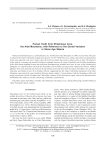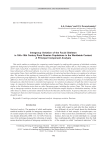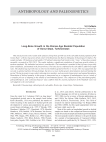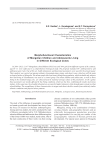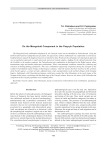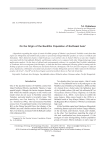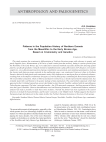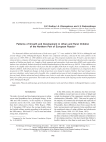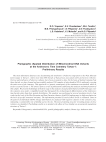Anthropology and paleogenetics. Рубрика в журнале - Archaeology, Ethnology & Anthropology of Eurasia
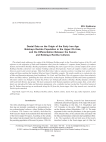
Статья научная
This dental study addresses the origin of the Bolshaya Rechka people in the Novosibirsk region of the Ob, with reference to the migration of Saka and Sarmatian tribes from the southwest. I compare dental features of southern Kamen and northern Bolshaya Rechka populations inhabiting the entire Upper Ob area. Dental samples from eleven Bolshaya Rechka cemeteries were studied. Findings indicate heterogeneity. Nearly all samples evidence admixture between eastern and western groups. That from Bystrovka-3 takes a separate position, revealing more eastern traits along with those marking the Southern Siberian Upper Paleolithic complex. The results enable us to evaluate the role of Saka and Sarmatian migrants from Kazakhstan, Cis-Urals, and Tian Shan. This role appears to have been relatively minor and likely indirect, upholding the ideas advanced by archaeologists. Bolshaya Rechka and Kamen populations (the latter culture was thought to include the former) are biologically distinct. Bolshaya Rechka displays continuity with local Early Bronze Age groups. The main component of the Kamen population of forest-steppe Altai, on the other hand, was introduced by Saka and Sarmatian immigrants, who, evidently, had not reached the Novosibirsk region of the Ob. Rather than moving on northwards along the Ob from the forest-steppe Altai, they turned west, toward the Tobol-Irtysh watershed.
Бесплатно
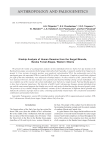
Kinship analysis of human remains from the Sargat mounds, Baraba forest-steppe, Western Siberia
Статья
Бесплатно
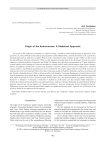
Origin of the Andronovans: A Statistical Approach
Статья научная
The origin of the Andronovo population is explored using a statistical rather than typological approach. Four questions are raised. Which Eastern European populations of the Middle Bronze and the transition to the Late Bronze Age had taken part in Andronovo origins? What was the contribution of the southern groups? What was the role of the autochthonous Siberian substratum? What was the population background of the dichotomy between two major Andronovo cultural traditions, Fedorovka and Alakul? To address these questions, measurements of 12 male Andronovo cranial samples (nine relating to Fedorovka and three to Alakul) and 85 male cranial samples from Eastern Europe, Siberia, Kazakhstan, Southwestern Central Asia, Southern Caucasus, and the Near East were subjected to canonical variate analysis, and minimum spanning trees were constructed. The results suggest that the most likely ancestors of Andronovans were Late Catacomb tribes of Northern Caucasus, people of Poltavka, Sintashta, and those associated with the Abashevo-Sintashta horizon. While no direct parallels with Southern Caucasian, Southwestern Central Asian or Near Eastern populations were found among Andronovo groups, some of them could have inherited the southern component from either the Abashevo or the Catacomb people. In the former case, one should postulate a gradient: Fatyanovo → Balanovo → Abashevo → Sintashta → Petrovka → Andronovo; in the latter case, the variation within Andronovo is directly derivable from that among the Catacomb populations. Andronovo groups displaying an autochthonous Siberian tendency demonstrate various degrees of “mutual assimilation” between immigrants and pre-Mongoloid natives. Differences between the Fedorovka and Alakul samples are significant but very small. A special role of Petrovka in the origin of Alakul is not supported by the analysis.
Бесплатно

Paleogenetic studies of migration processes in Eurasia
Статья научная
Migration processes played a key role in shaping the cultural and genetic landscapes in Eurasia. Significant progress in the field of migration studies in recent years is associated with the development of methods for studying ancient DNA, making it possible to reach a new level of understanding the population-genetic aspects of ancient migrations and significantly supplementing the evidence of paleoanthropology and genetics of modern populations, but not replacing these areas. A key challenge is the correct comparison of processes accompanying migrations at the population genetic level and at the level of material culture. The article highlights current methods used in studying ancient DNA, from the traditional analysis of individual genetic markers to the genome-wide analysis by high-throughput sequencing. Approaches to the study of ancient migrations and to the objective reconstruction of the genetic profile of populations and its dynamics in time and space are assessed. Special attention is paid to the problem of representative sampling in the study of migration processes using paleogenetic methods, and possible strategies for selecting the materials most adequate to the tasks of the study. Ways of enhancing the efficiency of the diachronic approach in reconstructing the genetic history of populations are discussed. Possible prospects of paleogenetic studies are evaluated, including the transition to more detailed reconstructions of local migration processes.
Бесплатно
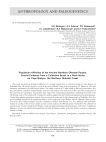
Статья научная
This study reconstructs biological affinities in a cranial sample from a collective burial on Cape Bratyev in Babushkin Bay. The burial, found in a rock niche on the Okhotsk Coast, was excavated by S.P. Efimov in 1976 and tentatively attributed to the Old Koryak culture. The sample consists of 13 adult skulls of differing preservation—five male, five female, and three undeterminable. Genome-wide analysis was carried out at the Center for Geogenetics of the University of Copenhagen. Paleogenetic data support the archaeological hypothesis attributing the burial to the Old Koryak culture. The results of the craniometric analysis suggest that the Old Koryak population was heterogeneous. Cranial data indicate population contacts between ancient Koryaks and the Epi-Jōmon people of Hokkaido. Also, they reveal common episodes in the population history of the group from Cape Bratyev and the Okhotsk culture people. Two of the three Okhotsk samples used for comparative analysis demonstrate very close affinities with individuals studied. According to the previous studies and our current analysis, the Okhotsk people resulted from the admixture of ancient groups related to Chukchi and Eskimo, on the one hand, and Tungus-Manchu groups, on the other. A significant difference between the Old Koryak population and that of Okhotsk culture is that the former includes a component related to Nivkhs.
Бесплатно
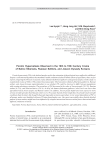
Статья научная
Porotic hyperostosis (PH) is the skeletal marker used in the estimation of physiological stress suffered in childhood. Despite a conventional hypothesis that mankind’s health conditions declined with the advent of agriculture, there are few reports comparing the PH seen on ancient crania of hunters-fishermen-gatherers and agrarian peoples. In this study, we examined the crania of 16th to 19th century Eurasian peoples: Siberian natives (hunters-fishermen-gatherers), Russian settlers, and Joseon Koreans (agriculturalists) to see whether PH could be observed to differ between populations with varying subsistence strategies. The prevalence of PH decreased in the order of Joseon people (18.9 %), Russian settlers (6.3 %), and Siberian natives (3.8 %). In brief, the hunters-fishermen-gatherers’ stress level was lower than agriculture-based Joseon people and Russian settlers. In addition, Joseon people might have been exposed to more serious stressful episodes than Russian settlers were. We assume that the former might have lived under much stressful conditions than the latter did, though both people depended on intense agriculture. As for sexual dimorphism of PH: in all groups, males were identified with more PH signs than females were. Our report successfully shows that the detailed pattern of stress markers might have been influenced by complex interactions between various factors that existed under different conditions in history.
Бесплатно
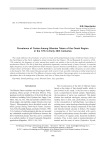
Prevalence of caries among Siberian Tatars of the Omsk region in the 17th to early 20th centuries
Статья обзорная
Бесплатно

